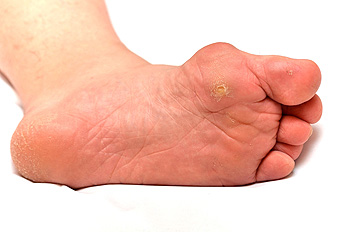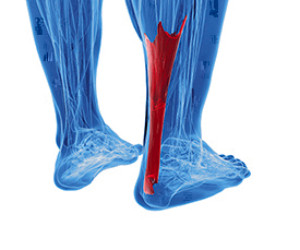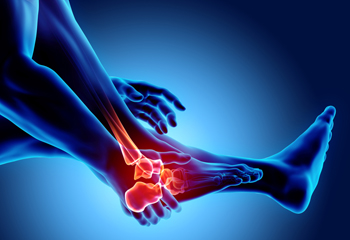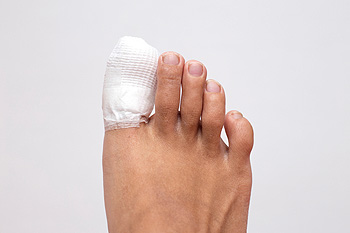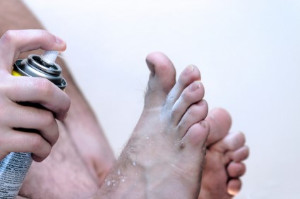Blogs
Possible Causes of Ingrown Toenails
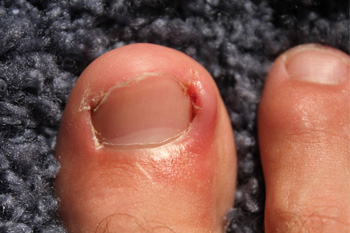 A condition that is known as ingrown toenails may be a result of the toenail growing into the surrounding skin. The big toe is typically affected, and can cause pain and discomfort. There are several symptoms that may be associated with this condition, including possible discharge, redness and irritation around the toe, and pain when the toe is touched. There are many reasons why this ailment might develop. These may include toenails that have been trimmed incorrectly, wearing shoes that may be too tight, or an injury that may have happened to the toe. If you have an ingrown toenail, it may be helpful to gently push the affected skin away from the nail. If it should become infected, it is advised that you consult a podiatrist who can discuss the best treatment options for you.
A condition that is known as ingrown toenails may be a result of the toenail growing into the surrounding skin. The big toe is typically affected, and can cause pain and discomfort. There are several symptoms that may be associated with this condition, including possible discharge, redness and irritation around the toe, and pain when the toe is touched. There are many reasons why this ailment might develop. These may include toenails that have been trimmed incorrectly, wearing shoes that may be too tight, or an injury that may have happened to the toe. If you have an ingrown toenail, it may be helpful to gently push the affected skin away from the nail. If it should become infected, it is advised that you consult a podiatrist who can discuss the best treatment options for you.
Ingrown toenails may initially present themselves as a minor discomfort, but they may progress into an infection in the skin without proper treatment. For more information about ingrown toenails, contact Dr. Dean D. Hinners of Illinois. Our doctor can provide the care you need to keep you pain-free and on your feet.
Ingrown Toenails
Ingrown toenails are caused when the corner or side of a toenail grows into the soft flesh surrounding it. They often result in redness, swelling, pain, and in some cases, infection. This condition typically affects the big toe and may recur if it is not treated properly.
Causes
- Improper toenail trimming
- Genetics
- Improper shoe fitting
- Injury from pedicures or nail picking
- Abnormal gait
- Poor hygiene
You are more likely to develop an ingrown toenail if you are obese, have diabetes, arthritis, or have any fungal infection in your nails. Additionally, people who have foot or toe deformities are at a higher risk of developing an ingrown toenail.
Symptoms
Some symptoms of ingrown toenails are redness, swelling, and pain. In rare cases, there may be a yellowish drainage coming from the nail.
Treatment
Ignoring an ingrown toenail can have serious complications. Infections of the nail border can progress to a deeper soft-tissue infection, which can then turn into a bone infection. You should always speak with your podiatrist if you suspect you have an ingrown toenail, especially if you have diabetes or poor circulation.
If you have any questions, please feel free to contact one of our offices located in Metropolis and Eldorado, IL . We offer the newest diagnostic and treatment technologies for all your foot care needs.
Possible Reasons Why Bunions May Develop
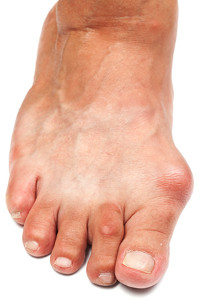 A bunion is considered to be a deformity of the bone. It appears as a protrusion on the side of the big toe, and is often swollen and painful. It is possible for the foot to change shape, and the style of the shoes may have to be altered. The reasons bunions develop can include genetic factors, wearing shoes that fit incorrectly, or medical conditions such as gout or rheumatoid arthritis. This condition can be treated by using bunion pads or wearing custom made orthotics. These may be helpful in alleviating pressure on the foot that comes from the bunion. If this ailment is causing severe pain and daily activities are difficult to complete, surgery may be a consideration for permanent removal of the bunion. Please consult with a podiatrist if you are afflicted with a bunion, and would like additional treatment options.
A bunion is considered to be a deformity of the bone. It appears as a protrusion on the side of the big toe, and is often swollen and painful. It is possible for the foot to change shape, and the style of the shoes may have to be altered. The reasons bunions develop can include genetic factors, wearing shoes that fit incorrectly, or medical conditions such as gout or rheumatoid arthritis. This condition can be treated by using bunion pads or wearing custom made orthotics. These may be helpful in alleviating pressure on the foot that comes from the bunion. If this ailment is causing severe pain and daily activities are difficult to complete, surgery may be a consideration for permanent removal of the bunion. Please consult with a podiatrist if you are afflicted with a bunion, and would like additional treatment options.
If you are suffering from bunions, contact Dr. Dean D. Hinners of Illinois. Our doctor can provide the care you need to keep you pain-free and on your feet.
What Is a Bunion?
A bunion is formed of swollen tissue or an enlargement of boney growth, usually located at the base joint of the toe that connects to the foot. The swelling occurs due to the bones in the big toe shifting inward, which impacts the other toes of the foot. This causes the area around the base of the big toe to become inflamed and painful.
Why Do Bunions Form?
Genetics – Susceptibility to bunions are often hereditary
Stress on the feet – Poorly fitted and uncomfortable footwear that places stress on feet, such as heels, can worsen existing bunions
How Are Bunions Diagnosed?
Doctors often perform two tests – blood tests and x-rays – when trying to diagnose bunions, especially in the early stages of development. Blood tests help determine if the foot pain is being caused by something else, such as arthritis, while x-rays provide a clear picture of your bone structure to your doctor.
How Are Bunions Treated?
- Refrain from wearing heels or similar shoes that cause discomfort
- Select wider shoes that can provide more comfort and reduce pain
- Anti-inflammatory and pain management drugs
- Orthotics or foot inserts
- Surgery
If you have any questions, please feel free to contact one of our offices located in Metropolis and Eldorado, IL . We offer the newest diagnostic and treatment technologies for all your foot care needs.
Can Walking Help Poor Circulation?
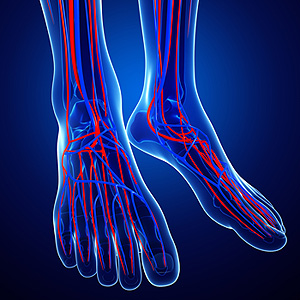 The medical condition that is known as poor circulation occurs when blood flow is restricted in the body. Common symptoms that are associated with this condition can include cold feet, in addition to a tingling and numbing sensation. This risk of developing poor circulation may increase as the aging process occurs. Other existing factors that can lead to this condition can include smoking, lack of exercise, and eating unhealthy foods. There are noticeable symptoms that are present if poor circulation exists. The most common sign is feeling cramps in your legs as you walk, and some patients are aware of consistent aches in their legs and feet. Mild relief can be obtained when a gentle walking program is implemented, and this can be helpful in controlling poor circulation. If you feel you have symptoms of this condition, it is suggested that you schedule a consultation with a podiatrist who can properly treat this condition.
The medical condition that is known as poor circulation occurs when blood flow is restricted in the body. Common symptoms that are associated with this condition can include cold feet, in addition to a tingling and numbing sensation. This risk of developing poor circulation may increase as the aging process occurs. Other existing factors that can lead to this condition can include smoking, lack of exercise, and eating unhealthy foods. There are noticeable symptoms that are present if poor circulation exists. The most common sign is feeling cramps in your legs as you walk, and some patients are aware of consistent aches in their legs and feet. Mild relief can be obtained when a gentle walking program is implemented, and this can be helpful in controlling poor circulation. If you feel you have symptoms of this condition, it is suggested that you schedule a consultation with a podiatrist who can properly treat this condition.
While poor circulation itself isn’t a condition; it is a symptom of another underlying health condition you may have. If you have any concerns with poor circulation in your feet contact Dr. Dean D. Hinners of Illinois. Our doctor will treat your foot and ankle needs.
Poor Circulation in the Feet
Peripheral artery disease (PAD) can potentially lead to poor circulation in the lower extremities. PAD is a condition that causes the blood vessels and arteries to narrow. In a linked condition called atherosclerosis, the arteries stiffen up due to a buildup of plaque in the arteries and blood vessels. These two conditions can cause a decrease in the amount of blood that flows to your extremities, therefore resulting in pain.
Symptoms
Some of the most common symptoms of poor circulation are:
- Numbness
- Tingling
- Throbbing or stinging pain in limbs
- Pain
- Muscle Cramps
Treatment for poor circulation often depends on the underlying condition that causes it. Methods for treatment may include insulin for diabetes, special exercise programs, surgery for varicose veins, or compression socks for swollen legs.
As always, see a podiatrist as he or she will assist in finding a regimen that suits you. A podiatrist can also prescribe you any needed medication.
If you have any questions, please feel free to contact one of our offices located in Metropolis and Eldorado, IL . We offer the newest diagnostic and treatment technologies for all your foot care needs.
How Do Bunions Form?
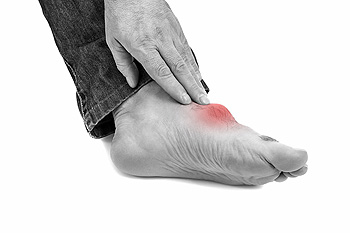 Bunions can arise for a number of different reasons. Some factors that may lead to one getting a bunion include inheriting a bunion tendency, commonly wearing ill-fitting shoes such as high heels, and having rheumatoid arthritis. Other reasons may include birth deformities as well as foot stresses or injuries. A bulging, bony bump on the base of the big toe is a key indicator that you might have a bunion. Along with having a bony bump, swelling, redness, and soreness are additional symptoms that may come with this foot condition. Corns or calluses may also form due to the toes rubbing against each other. If you are experiencing continuous foot pain or decreased mobility of your big toe, we recommend you meet with a podiatrist for a proper diagnosis and advised treatment plan.
Bunions can arise for a number of different reasons. Some factors that may lead to one getting a bunion include inheriting a bunion tendency, commonly wearing ill-fitting shoes such as high heels, and having rheumatoid arthritis. Other reasons may include birth deformities as well as foot stresses or injuries. A bulging, bony bump on the base of the big toe is a key indicator that you might have a bunion. Along with having a bony bump, swelling, redness, and soreness are additional symptoms that may come with this foot condition. Corns or calluses may also form due to the toes rubbing against each other. If you are experiencing continuous foot pain or decreased mobility of your big toe, we recommend you meet with a podiatrist for a proper diagnosis and advised treatment plan.
If you are suffering from bunion pain, contact Dr. Dean D. Hinners of Illinois. Our doctor can provide the care you need to keep you pain-free and on your feet.
What Is a Bunion?
Bunions are painful bony bumps that usually develop on the inside of the foot at the joint of the big toe. As the deformity increases over time, it may become painful to walk and wear shoes. Women are more likely to exacerbate existing bunions since they often wear tight, narrow shoes that shift their toes together. Bunion pain can be relieved by wearing wider shoes with enough room for the toes.
Causes
- Genetics – some people inherit feet that are more prone to bunion development
- Inflammatory Conditions - rheumatoid arthritis and polio may cause bunion development
Symptoms
- Redness and inflammation
- Pain and tenderness
- Callus or corns on the bump
- Restricted motion in the big toe
In order to diagnose your bunion, your podiatrist may ask about your medical history, symptoms, and general health. Your doctor might also order an x-ray to take a closer look at your feet. Nonsurgical treatment options include orthotics, padding, icing, changes in footwear, and medication. If nonsurgical treatments don’t alleviate your bunion pain, surgery may be necessary.
If you have any questions, please feel free to contact one of our offices located in Metropolis and Eldorado, IL . We offer the newest diagnostic and treatment technologies for all your foot care needs.
Wearing High Heels While Working
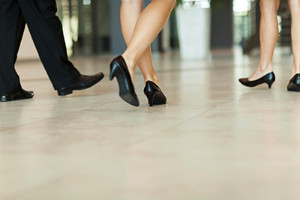 Many patients experience foot pain at the end of their working day. This may be a result of wearing shoes that do not fit correctly, or it may come from standing for extended periods of time throughout the day. Some work environments require high heels to be worn. If this is true for you, it may be beneficial to wear the lowest heel that is acceptable in the work environment, in addition to frequently stretching the calf muscles during the day. Additionally, it may be favorable to wear shoes that are made of breathable materials, and to alternate them with another pair, as this may help to avoid discomfort. If you would like additional information about how to protect your feet while working, please schedule an appointment with a podiatrist.
Many patients experience foot pain at the end of their working day. This may be a result of wearing shoes that do not fit correctly, or it may come from standing for extended periods of time throughout the day. Some work environments require high heels to be worn. If this is true for you, it may be beneficial to wear the lowest heel that is acceptable in the work environment, in addition to frequently stretching the calf muscles during the day. Additionally, it may be favorable to wear shoes that are made of breathable materials, and to alternate them with another pair, as this may help to avoid discomfort. If you would like additional information about how to protect your feet while working, please schedule an appointment with a podiatrist.
While working on the feet, it is important to take the proper care of them. For more information about working on your feet, contact Dr. Dean D. Hinners from Illinois. Our doctor will treat your foot and ankle needs.
Working on Your Feet
Standing on your feet for long periods of time can cause stress and pain in your feet. Your whole body may experience change in terms of posture, back pain, bunions, callouses and or plantar warts. There are ways to avoid these conditions with proper foot care, smart choices and correct posture.
Positive Changes
Negative heeled shoe – Choosing this shoe type places the heel slightly lower than the ball of the foot. These are great for overall foot health. Find shoes that fit you correctly.
Go barefoot – Our feet were not designed to be enclosed for all hours of the day. Try to periodically expose your feet to air.
Eliminate Pain
Foot Exercises – Performing simple exercises, incorporating yoga and doing stretches are beneficial. This will allow increased blood flow to the area and muscles of the foot.
Achilles tendon – Stretching the foot out flat on the floor will relax the calf muscles and tendon. These exercises can be performed almost anywhere. Make sure you add these exercises to your daily regimen.
With a little bit of this information and knowing more about foot health, you will notice changes. Foot stretches and proper footwear will help with pain and prevent further issues.
If you have any questions please feel free to contact one of our offices located in Metropolis and Eldorado, IL . We offer the newest diagnostic and treatment technologies for all your foot and ankle needs.
Where Is the Plantar Fascia?
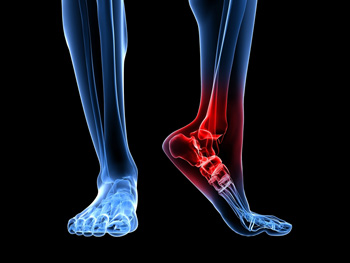 The portion of tissue that is found on the bottom of the foot is called the plantar fascia. It connects the heel to the toes, and helps to provide flexibility to the foot while walking and running. When this band of tissue becomes inflamed as a result of an injury or from overuse, the condition plantar fasciitis may develop. The symptoms that are generally associated with this condition can include severe pain and discomfort in the heel and surrounding area, and this pain may be worse in the morning after arising. Some patients find mild relief when the affected foot is rolled on a cold bottle, as this may be helpful in relaxing the affected muscles. If you suffer from plantar fasciitis, it is strongly suggested that you are under the care of a podiatrist who can properly treat this condition.
The portion of tissue that is found on the bottom of the foot is called the plantar fascia. It connects the heel to the toes, and helps to provide flexibility to the foot while walking and running. When this band of tissue becomes inflamed as a result of an injury or from overuse, the condition plantar fasciitis may develop. The symptoms that are generally associated with this condition can include severe pain and discomfort in the heel and surrounding area, and this pain may be worse in the morning after arising. Some patients find mild relief when the affected foot is rolled on a cold bottle, as this may be helpful in relaxing the affected muscles. If you suffer from plantar fasciitis, it is strongly suggested that you are under the care of a podiatrist who can properly treat this condition.
Plantar fasciitis can be very painful and inconvenient. If you are experiencing heel pain or symptoms of plantar fasciitis, contact Dr. Dean D. Hinners from Illinois. Our doctor can provide the care you need to keep you pain-free and on your feet.
What Is Plantar Fasciitis?
Plantar fasciitis is the inflammation of the thick band of tissue that runs along the bottom of your foot, known as the plantar fascia, and causes mild to severe heel pain.
What Causes Plantar Fasciitis?
- Excessive running
- Non-supportive shoes
- Overpronation
- Repeated stretching and tearing of the plantar fascia
How Can It Be Treated?
- Conservative measures – anti-inflammatories, ice packs, stretching exercises, physical therapy, orthotic devices
- Shockwave therapy – sound waves are sent to the affected area to facilitate healing and are usually used for chronic cases of plantar fasciitis
- Surgery – usually only used as a last resort when all else fails. The plantar fascia can be surgically detached from the heel
While very treatable, plantar fasciitis is definitely not something that should be ignored. Especially in severe cases, speaking to your doctor right away is highly recommended to avoid complications and severe heel pain. Your podiatrist can work with you to provide the appropriate treatment options tailored to your condition.
If you have any questions please feel free to contact one of our offices located in Metropolis and Eldorado, IL . We offer the newest diagnostic and treatment technologies for all your foot and ankle needs.
Common Symptoms That Are Associated With Rheumatoid Arthritis
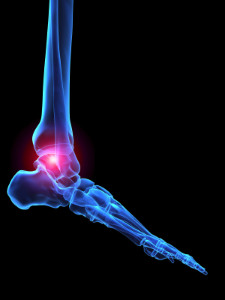 The medical condition that is known as rheumatoid arthritis (RA) can cause the patient to experience pain and discomfort, in addition to having deformed toes. It may be difficult to stand for extended periods of time, and the feet can ache for the majority of the day. The joints often become weak, which can be a result of tissue, bone, and cartilage breaking down. A common symptom is swelling, and patients may find it difficult to complete daily activities. The feet may change shape, and larger shoes may have to be worn that can accommodate the changing foot. Patients who are afflicted with RA can find relief when the feet are elevated, and it may feel better to soak the feet in warm water. If you have symptoms of rheumatoid arthritis in the feet, it is strongly advised that you consult with a podiatrist who can help you to manage this condition.
The medical condition that is known as rheumatoid arthritis (RA) can cause the patient to experience pain and discomfort, in addition to having deformed toes. It may be difficult to stand for extended periods of time, and the feet can ache for the majority of the day. The joints often become weak, which can be a result of tissue, bone, and cartilage breaking down. A common symptom is swelling, and patients may find it difficult to complete daily activities. The feet may change shape, and larger shoes may have to be worn that can accommodate the changing foot. Patients who are afflicted with RA can find relief when the feet are elevated, and it may feel better to soak the feet in warm water. If you have symptoms of rheumatoid arthritis in the feet, it is strongly advised that you consult with a podiatrist who can help you to manage this condition.
Because RA affects more than just your joints, including the joints in your feet and ankles, it is important to seek early diagnosis from your podiatrist if you feel like the pain in your feet might be caused by RA. For more information, contact Dr. Dean D. Hinners of Illinois. Our doctor will assist you with all of your podiatric concerns.
What Is Rheumatoid Arthritis?
Rheumatoid Arthritis (RA) is an autoimmune disorder in which the body’s own immune system attacks the membranes surrounding the joints. Inflammation of the lining and eventually the destruction of the joint’s cartilage and bone occur, causing severe pain and immobility.
Rheumatoid Arthritis of the Feet
Although RA usually attacks multiple bones and joints throughout the entire body, almost 90 percent of cases result in pain in the foot or ankle area.
Symptoms
- Swelling and pain in the feet
- Stiffness in the feet
- Pain on the ball or sole of feet
- Joint shift and deformation
Diagnosis
Quick diagnosis of RA in the feet is important so that the podiatrist can treat the area effectively. Your doctor will ask you about your medical history, occupation, and lifestyle to determine the origin of the condition. Rheumatoid Factor tests help to determine if someone is affected by the disease.
If you have any questions please feel free to contact one of our offices located in Metropolis and Eldorado, IL . We offer the newest diagnostic and treatment technologies for all your foot and ankle needs.
An Overview of Calluses and Corns
Calluses and corns are thickened areas of skin on the feet. They are usually caused by excess friction or pressure on the foot. The outer layer of skin hardens to protect the tissue and bone beneath the skin. Calluses can occur anywhere on the foot, while corns develop on or in between the toes. The people who are most at risk for developing calluses and corns include those who are very physically active, wear poorly-fitted shoes, don’t wear socks with their shoes, and have other foot problems. If you find yourself with painful calluses or corns, it is suggested that you see a podiatrist for treatment.
Corns can make walking very painful and should be treated immediately. If you have questions regarding your feet and ankles, contact Dr. Dean D. Hinners of Illinois. Our doctor will treat your foot and ankle needs.
Corns: What Are They? And How Do You Get Rid of Them?
Corns are thickened areas on the skin that can become painful. They are caused by excessive pressure and friction on the skin. Corns press into the deeper layers of the skin and are usually round in shape.
Ways to Prevent Corns
There are many ways to get rid of painful corns such as:
- Wearing properly fitting shoes that have been measured by a professional
- Wearing shoes that are not sharply pointed or have high heels
- Wearing only shoes that offer support
Treating Corns
Although most corns slowly disappear when the friction or pressure stops, this isn’t always the case. Consult with your podiatrist to determine the best treatment option for your case of corns.
If you have any questions please feel free to contact one of our offices located in Metropolis and Eldorado, IL . We offer the newest diagnostic and treatment technologies for all your foot and ankle needs.
Gout Can Affect the Joints in the Big Toe
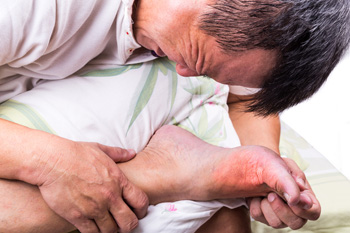 A type of arthritis that is referred to as gout is considered to be common among men over the age of forty. It generally occurs from an increased level of uric acid in the blood, which can happen for a variety of reasons. These can consist of genetic factors, underlying medical conditions, or from eating foods that have large amounts of purines. These specific types of foods often include red meat, shellfish, and drinks that have a high sugar content. The symptoms that are associated with gout are severe pain and discomfort in the joints of the big toe, swelling, and extreme tenderness. Some patients can experience pain that is so debilitating, it can hinder their ability to walk. When treating gout, it may be beneficial to implement healthy eating habits into your daily routine, and taking anti-inflammatory medication may relieve pain. If you have gout, it is suggested that you are under the care of a podiatrist who can help you to manage this condition.
A type of arthritis that is referred to as gout is considered to be common among men over the age of forty. It generally occurs from an increased level of uric acid in the blood, which can happen for a variety of reasons. These can consist of genetic factors, underlying medical conditions, or from eating foods that have large amounts of purines. These specific types of foods often include red meat, shellfish, and drinks that have a high sugar content. The symptoms that are associated with gout are severe pain and discomfort in the joints of the big toe, swelling, and extreme tenderness. Some patients can experience pain that is so debilitating, it can hinder their ability to walk. When treating gout, it may be beneficial to implement healthy eating habits into your daily routine, and taking anti-inflammatory medication may relieve pain. If you have gout, it is suggested that you are under the care of a podiatrist who can help you to manage this condition.
Gout is a painful condition that can be treated. If you are seeking treatment, contact Dr. Dean D. Hinners from Illinois. Our doctor will treat your foot and ankle needs.
What Is Gout?
Gout is a form of arthritis that is characterized by sudden, severe attacks of pain, redness, and tenderness in the joints. The condition usually affects the joint at the base of the big toe. A gout attack can occur at any random time, such as the middle of the night while you are asleep.
Symptoms
- Intense Joint Pain - Usually around the large joint of your big toe, and it most severe within the first four to twelve hours
- Lingering Discomfort - Joint discomfort may last from a few days to a few weeks
- Inflammation and Redness -Affected joints may become swollen, tender, warm and red
- Limited Range of Motion - May experience a decrease in joint mobility
Risk Factors
- Genetics - If family members have gout, you’re more likely to have it
- Medications - Diuretic medications can raise uric acid levels
- Gender/Age - Gout is more common in men until the age of 60. It is believed that estrogen protects women until that point
- Diet - Eating red meat and shellfish increases your risk
- Alcohol - Having more than two alcoholic drinks per day increases your risk
- Obesity - Obese people are at a higher risk for gout
Prior to visiting your podiatrist to receive treatment for gout, there are a few things you should do beforehand. If you have gout you should write down your symptoms--including when they started and how often you experience them, important medical information you may have, and any questions you may have. Writing down these three things will help your podiatrist in assessing your specific situation so that he or she may provide the best route of treatment for you.
If you have any questions, please feel free to contact one of our offices located in Metropolis and Eldorado, IL . We offer the newest diagnostic and treatment technologies for all your foot care needs.
What Causes Achilles Tendon Injuries?
The Achilles tendon is a band of tissue that connects the muscles in your calf to your heel. The Achilles tendon endures a lot of stress and pressure during daily activities and exercise. Sometimes, the stress and pressure may become excessive, leading to an injury. Achilles tendonitis refers to an inflammation of the Achilles tendon. It typically stems from overuse and can cause symptoms such as pain and swelling. There are two types of Achilles tendonitis, insertional and noninsertional. In insertional tendonitis, the damage to the tendon occurs where the tendon meets the heel bone. Insertional tendonitis can occur at any age, both in active and in sedentary people, and is often associated with the development of bone spurs. Non-insertional Achilles tendonitis occurs when small tears in the middle fibers of the tendon start to break down. Non-insertional tendonitis typically affects young, active people. If you experience an injury to the Achilles tendon, it is recommended that you seek the care of a podiatrist.
Achilles tendon injuries need immediate attention to avoid future complications. If you have any concerns, contact Dr. Dean D. Hinners of Illinois. Our doctor can provide the care you need to keep you pain-free and on your feet.
What Is the Achilles Tendon?
The Achilles tendon is a tendon that connects the lower leg muscles and calf to the heel of the foot. It is the strongest tendon in the human body and is essential for making movement possible. Because this tendon is such an integral part of the body, any injuries to it can create immense difficulties and should immediately be presented to a doctor.
What Are the Symptoms of an Achilles Tendon Injury?
There are various types of injuries that can affect the Achilles tendon. The two most common injuries are Achilles tendinitis and ruptures of the tendon.
Achilles Tendinitis Symptoms
- Inflammation
- Dull to severe pain
- Increased blood flow to the tendon
- Thickening of the tendon
Rupture Symptoms
- Extreme pain and swelling in the foot
- Total immobility
Treatment and Prevention
Achilles tendon injuries are diagnosed by a thorough physical evaluation, which can include an MRI. Treatment involves rest, physical therapy, and in some cases, surgery. However, various preventative measures can be taken to avoid these injuries, such as:
- Thorough stretching of the tendon before and after exercise
- Strengthening exercises like calf raises, squats, leg curls, leg extensions, leg raises, lunges, and leg presses
If you have any questions please feel free to contact one of our offices located in Metropolis and Eldorado, IL . We offer the newest diagnostic tools and technology to treat your foot and ankle needs.
More...
Early Signs and Risk Factors of Rheumatoid Arthritis
Rheumatoid arthritis (RA) is an autoimmune disorder that causes the immune system to attack healthy tissue in the joints. Often, the joints of the feet and ankles are affected. Early symptoms of RA include joint pain during movement and at rest, swelling, tenderness, or warmth in the joints, joint stiffness, low energy or fatigue, a low-grade fever, and a loss of appetite. RA affects 1.5 million people in the United States, and there are several risk factors that can make someone more likely to develop RA. These risk factors include being 60 years of age or older, being female, and being obese. If you develop symptoms of RA in the joints of your feet and ankles, it is suggested that you see a podiatrist to help you manage this condition.
Because RA affects more than just your joints, including the joints in your feet and ankles, it is important to seek early diagnosis from your podiatrist if you feel like the pain in your feet might be caused by RA. For more information, contact Dr. Dean D. Hinners of Illinois. Our doctor will assist you with all of your podiatric concerns.
What Is Rheumatoid Arthritis?
Rheumatoid Arthritis (RA) is an autoimmune disorder in which the body’s own immune system attacks the membranes surrounding the joints. Inflammation of the lining and eventually the destruction of the joint’s cartilage and bone occur, causing severe pain and immobility.
Rheumatoid Arthritis of the Feet
Although RA usually attacks multiple bones and joints throughout the entire body, almost 90 percent of cases result in pain in the foot or ankle area.
Symptoms
- Swelling and pain in the feet
- Stiffness in the feet
- Pain on the ball or sole of feet
- Joint shift and deformation
Diagnosis
Quick diagnosis of RA in the feet is important so that the podiatrist can treat the area effectively. Your doctor will ask you about your medical history, occupation, and lifestyle to determine the origin of the condition. Rheumatoid Factor tests help to determine if someone is affected by the disease.
If you have any questions please feel free to contact one of our offices located in Metropolis and Eldorado, IL . We offer the newest diagnostic and treatment technologies for all your foot and ankle needs.
Symptoms of a Broken Toe
A broken toe can be a very painful condition. It may happen as the result of a sudden injury, or from repetitive overuse while running or playing sports. Weakened bones, due to conditions like osteoporosis, can also lead to toe fractures. There are several symptoms of a broken bone that you should be aware of. If you have been suddenly injured, you may hear a popping or cracking sound at the time of injury. This could be indicative of a broken bone. Some broken bones can protrude through the skin or look deformed or misaligned. Other indicators of a broken bone include intense pain, numbness or tingling, swelling, bruising, and a loss of mobility. Broken toes require medical attention. If you have any symptoms of a broken toe, it is suggested that you see a podiatrist as soon as possible.
A broken toe can be very painful and lead to complications if not properly fixed. If you have any concerns about your feet, contact Dr. Dean D. Hinners from Illinois. Our doctor will treat your foot and ankle needs.
What to Know About a Broken Toe
Although most people try to avoid foot trauma such as banging, stubbing, or dropping heavy objects on their feet, the unfortunate fact is that it is a common occurrence. Given the fact that toes are positioned in front of the feet, they typically sustain the brunt of such trauma. When trauma occurs to a toe, the result can be a painful break (fracture).
Symptoms of a Broken Toe
- Throbbing pain
- Swelling
- Bruising on the skin and toenail
- The inability to move the toe
- Toe appears crooked or disfigured
- Tingling or numbness in the toe
Generally, it is best to stay off of the injured toe with the affected foot elevated.
Severe toe fractures may be treated with a splint, cast, and in some cases, minor surgery. Due to its position and the pressure it endures with daily activity, future complications can occur if the big toe is not properly treated.
If you have any questions please feel free to contact one of our offices located in Metropolis and Eldorado, IL . We offer the newest diagnostic and treatment technologies for all your foot and ankle needs.
Is It Dry Skin or Athlete's Foot?
Both dry skin and athlete’s foot are conditions that can affect the skin of the feet. Dry skin is characterized by a rough, flaky, or scaly texture and possible cracking, itchiness, irritation or redness. Athlete’s foot is a fungal infection of the skin of the feet and is characterized by red, itchy scales on the feet, a burning or stinging sensation, cracking or flaking skin, oozing blisters, and changes in the texture or color of the toenails. Because both conditions can make the skin of the feet dry, itchy, or irritated, it can sometimes be difficult to tell dry skin and athlete’s foot apart. For this reason, it is suggested that you seek the counsel of a podiatrist, who can determine the root of the problem and offer the appropriate treatments.
Athlete’s foot is an inconvenient condition that can be easily reduced with the proper treatment. If you have any concerns about your feet and ankles, contact Dr. Dean D. Hinners from Illinois. Our doctor will treat your foot and ankle needs.
Athlete’s Foot: The Sole Story
Athlete's foot, also known as tinea pedis, can be an extremely contagious foot infection. It is commonly contracted in public changing areas and bathrooms, dormitory style living quarters, around locker rooms and public swimming pools, or anywhere your feet often come into contact with other people.
Solutions to Combat Athlete’s Foot
- Hydrate your feet by using lotion
- Exfoliate
- Buff off nails
- Use of anti-fungal products
- Examine your feet and visit your doctor if any suspicious blisters or cuts develop
Athlete’s foot can cause many irritating symptoms such as dry and flaking skin, itching, and redness. Some more severe symptoms can include bleeding and cracked skin, intense itching and burning, and even pain when walking. In the worst cases, Athlete’s foot can cause blistering as well. Speak to your podiatrist for a better understanding of the different causes of Athlete’s foot, as well as help in determining which treatment options are best for you.
If you have any questions please feel free to contact one of our offices located in Metropolis and Eldorado, IL . We offer the newest diagnostic and treatment technologies for all your foot and ankle needs.
What Are the Most Common Exercise Foot Injuries?
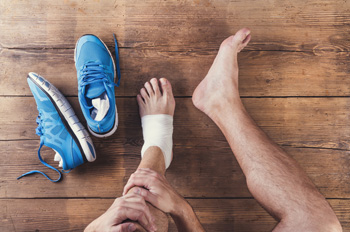 Exercising is an important part of maintaining your overall health, but can lead to various foot injuries if you are not careful. Common exercise-related foot injuries include Achilles tendonitis, plantar fasciitis, stress fractures, sprained ankles, pinched nerves, and heel spurs. Interestingly, exercises that target strengthening and stretching the feet can help reduce your risk of exercise-related foot injuries. Some exercises that can help prevent foot injuries include calf stretches and raises, toe lifts, and toe and heel walking. To learn more about preventing foot injuries, please consult with a podiatrist.
Exercising is an important part of maintaining your overall health, but can lead to various foot injuries if you are not careful. Common exercise-related foot injuries include Achilles tendonitis, plantar fasciitis, stress fractures, sprained ankles, pinched nerves, and heel spurs. Interestingly, exercises that target strengthening and stretching the feet can help reduce your risk of exercise-related foot injuries. Some exercises that can help prevent foot injuries include calf stretches and raises, toe lifts, and toe and heel walking. To learn more about preventing foot injuries, please consult with a podiatrist.
Sports related foot and ankle injuries require proper treatment before players can go back to their regular routines. For more information, contact Dr. Dean D. Hinners of Illinois. Our doctor can provide the care you need to keep you pain-free and on your feet.
Sports Related Foot and Ankle Injuries
Foot and ankle injuries are a common occurrence when it comes to athletes of any sport. While many athletes dismiss the initial aches and pains, the truth is that ignoring potential foot and ankle injuries can lead to serious problems. As athletes continue to place pressure and strain the area further, a mild injury can turn into something as serious as a rupture and may lead to a permanent disability. There are many factors that contribute to sports related foot and ankle injuries, which include failure to warm up properly, not providing support or wearing bad footwear. Common injuries and conditions athletes face, including:
- Plantar Fasciitis
- Plantar Fasciosis
- Achilles Tendinitis
- Achilles Tendon Rupture
- Ankle Sprains
Sports related injuries are commonly treated using the RICE method. This includes rest, applying ice to the injured area, compression and elevating the ankle. More serious sprains and injuries may require surgery, which could include arthroscopic and reconstructive surgery. Rehabilitation and therapy may also be required in order to get any recovering athlete to become fully functional again. Any unusual aches and pains an athlete sustains must be evaluated by a licensed, reputable medical professional.
If you have any questions please feel free to contact one of our offices located in Metropolis and Eldorado, IL . We offer the newest diagnostic and treatment technologies for all your foot and ankle needs.
